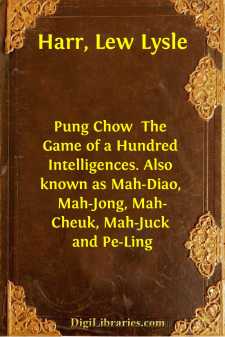Categories
- Antiques & Collectibles 13
- Architecture 36
- Art 48
- Bibles 22
- Biography & Autobiography 813
- Body, Mind & Spirit 142
- Business & Economics 28
- Children's Books 17
- Children's Fiction 14
- Computers 4
- Cooking 94
- Crafts & Hobbies 4
- Drama 346
- Education 46
- Family & Relationships 57
- Fiction 11829
- Games 19
- Gardening 17
- Health & Fitness 34
- History 1377
- House & Home 1
- Humor 147
- Juvenile Fiction 1873
- Juvenile Nonfiction 202
- Language Arts & Disciplines 88
- Law 16
- Literary Collections 686
- Literary Criticism 179
- Mathematics 13
- Medical 41
- Music 40
- Nature 179
- Non-Classifiable 1768
- Performing Arts 7
- Periodicals 1453
- Philosophy 64
- Photography 2
- Poetry 896
- Political Science 203
- Psychology 42
- Reference 154
- Religion 513
- Science 126
- Self-Help 84
- Social Science 81
- Sports & Recreation 34
- Study Aids 3
- Technology & Engineering 59
- Transportation 23
- Travel 463
- True Crime 29
Pung Chow The Game of a Hundred Intelligences. Also known as Mah-Diao, Mah-Jong, Mah-Cheuk, Mah-Juck and Pe-Ling
by: Lew Lysle Harr
Categories:
Description:
Excerpt
INTRODUCTION
Out of China has come this stately game with the lure of Oriental mysticism to whet jaded appetites and with possibilities for study that challenge the keenest intelligence.
There is a mysticism about the Oriental and his mode of life that challenges the imagination and induces a curiosity hard to decipher. The dress of the Chinese, their strange customs, their difficult language, and their apparently impenetrable mask-like faces appeal to the fancy and throw a veil of mystery around even the commonplace.
The origin of this game is lost in the mist of centuries past. There is, though, an oral tradition to the effect that it was originated in the Court of the King of Wu, now known as Ning-Po, during the year of 472 B.C. to entertain his consort and her court ladies and to help them while away the time which lay heavily on their hands. This was about the time of Confucius. It is, however, known to have been the Royal game, restricted to the use of Emperors and their friends of the Mandarin class for two thousand years. To them it was known as Pe-Ling (pronounced Bah-Ling) taking its name from the "bird of a hundred intelligences," the lark-like creature sacred in the Chinese faith which now may be seen reproduced on most Chinese tapestries and embroideries. The penalty paid by one of any other class for playing Pe-Ling at that time, was the loss of his head. Later—no one knows just when—the privilege of playing this wonder game was extended to the merchant or middle classes—and when, some 70 years ago—a social uprising threatened, one of the concessions granted to calm the unrest was the universal privilege of playing this game. In this way was caused the confusion of names for the game which exists even to-day in China; for, with the abolishing of Pe-Ling, each province applied their own name and pronunciation to the game, with the result that now we have from twelve to eighteen different names, by which the game is known. A few of these are Ma-Cheuk, Mah-Jong, Mah-Juck, Mah-Diao and Mah-Jongg.
Pung Chow is made to withstand the climatic conditions which soon destroy the article imported under the name of Mah-Jongg and the other corruptions of Mah-Diao, and it is the true and original Chinese game translated by the addition of numerals just enough to be readily understood and not enough to spoil the artistry of the tiles. The addition of numerals has been overdone in the marking of many of the cheaper imported sets, and give the appearance of having had numerals sprinkled on them regardless of where they may land and permitted to stay.
The fundamentals of this game are simple and require only practice to master. The science of Pung Chow must in the greater part be studied out by the individual player and one may spend the rest of his life in attaining to past mastery in its thousand-fold intricacies.
Before going thoroughly into the details of the playing of the game, it is better to give a general view of the play and its object.
Pung Chow is played by thoroughly shuffling all of the tiles face down in the middle of the table, and forming them in a double-tiered, hollow square, called the wall. This wall is then broken at some point determined by the dice and each player draws an original hand of 13 tiles. This leaves about two-thirds of the wall intact, and the rest of the play is devoted to drawing and discarding from this remainder of the wall; each player improving and matching his own individual hand until having arranged it into four sets and a pair, some player wins....


